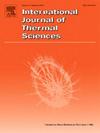纳米碳纤维对压电纤维增强PVDF多尺度复合材料传热性能的影响:层次细观力学分析
IF 4.9
2区 工程技术
Q1 ENGINEERING, MECHANICAL
International Journal of Thermal Sciences
Pub Date : 2025-07-17
DOI:10.1016/j.ijthermalsci.2025.110155
引用次数: 0
摘要
采用微力学分层方法研究了纳米碳纤维对PZT-5H压电纤维增强聚偏氟乙烯(PVDF)复合材料导热性能的影响。首先,利用CNF与聚合物的界面热阻(ITR)、含量、各向异性行为、CNF的长度、直径、直线度因子和聚类现象等变量,建立了CNF/聚合物复合材料导热性能的微观力学模型。然后,以PVDF/CNF材料为基体相,PZT-5H纤维为增强相,采用基于单元胞的微力学模型对压电纤维/CNF/聚合物多尺度复合材料的导热系数进行了预测。比较表明,在目前的预测、实验测量和其他数值/分析结果之间有很好的一致性。研究发现,少量CNFs的加入可以提高压电多尺度复合材料的轴向导热系数和横向导热系数。含有50 vol% PZT-5H和1.5 vol% CNFs的多尺度复合材料的轴向和横向导热系数分别高达0.225 W/m K和0.209 W/m K,与PZT-5H/PVDF复合材料相比,分别提高了38.9%和30%。CNFs的非直线形状和聚类,以及ITR导致导热系数的降低。长度越长、直径越小的纳米纤维对PZT-5H/PVDF/CNF复合材料的传热性能越好。本文章由计算机程序翻译,如有差异,请以英文原文为准。
Effect of carbon nanofibers on the heat transfer performance of piezoelectric fiber-reinforced PVDF multiscale composites: A hierarchical micromechanics analysis
A micromechanical method is developed in hierarchy to evaluate the influence of carbon nanofibers (CNFs) on the thermal conducting behaviors of PZT-5H piezoelectric fiber-reinforced polyvinylidene fluoride (PVDF) composites. First, a micromechanics model for the thermal conductivity of CNF/polymer composites is presented with variables of the interfacial thermal resistance (ITR) among the CNF and polymer, content, anisotropic behavior, length, diameter, straightness factor and clustering phenomena of CNFs. Then, considering the PVDF/CNF material as the matrix phase and PZT-5H fibers as reinforcements, a unit cell-based micromechanical model is employed to predict the thermal conductivity of piezoelectric fiber/CNF/polymer multiscale composites. Comparisons show an excellent agreement between the present predictions, experimental measurements and other numerical/analytical results. It is found that axial and transverse thermal conductivities of piezoelectric multiscale composites are improved by a small percentage of CNFs. A multiscale composite containing 50 vol% PZT-5H and 1.5 vol% CNFs shows axial and transverse thermal conductivities up to 0.225 W/m K and 0.209 W/m K, respectively, corresponding to 38.9 % and 30 % improvements as compared to the PZT-5H/PVDF composite. The non-straightness shape and clustering of CNFs, and the ITR lead to a reduction in thermal conductivities. Nanofibers with the higher length and lower diameter show a more enhancement on the heat transfer performance of PZT-5H/PVDF/CNF composites.
求助全文
通过发布文献求助,成功后即可免费获取论文全文。
去求助
来源期刊

International Journal of Thermal Sciences
工程技术-工程:机械
CiteScore
8.10
自引率
11.10%
发文量
531
审稿时长
55 days
期刊介绍:
The International Journal of Thermal Sciences is a journal devoted to the publication of fundamental studies on the physics of transfer processes in general, with an emphasis on thermal aspects and also applied research on various processes, energy systems and the environment. Articles are published in English and French, and are subject to peer review.
The fundamental subjects considered within the scope of the journal are:
* Heat and relevant mass transfer at all scales (nano, micro and macro) and in all types of material (heterogeneous, composites, biological,...) and fluid flow
* Forced, natural or mixed convection in reactive or non-reactive media
* Single or multi–phase fluid flow with or without phase change
* Near–and far–field radiative heat transfer
* Combined modes of heat transfer in complex systems (for example, plasmas, biological, geological,...)
* Multiscale modelling
The applied research topics include:
* Heat exchangers, heat pipes, cooling processes
* Transport phenomena taking place in industrial processes (chemical, food and agricultural, metallurgical, space and aeronautical, automobile industries)
* Nano–and micro–technology for energy, space, biosystems and devices
* Heat transport analysis in advanced systems
* Impact of energy–related processes on environment, and emerging energy systems
The study of thermophysical properties of materials and fluids, thermal measurement techniques, inverse methods, and the developments of experimental methods are within the scope of the International Journal of Thermal Sciences which also covers the modelling, and numerical methods applied to thermal transfer.
 求助内容:
求助内容: 应助结果提醒方式:
应助结果提醒方式:


